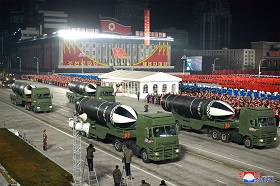On September 21, 2021, President of South Korea Moon Jae-in addressed the UN General Assembly, calling for a formal end to the Korean War of 1950–1953. “I … propose that the three parties of the two Koreas and the U.S. or the four parties of the two Koreas, the U.S. and China come together and declare that the war on the Korean Peninsula is over,” Moon Jae-in said.
President Moon has done his outmost best to build bridges between the two Koreas. The inter-Korean summits of 2018 yielded some positive results—in the near future, there will be no war in Korea, whether nuclear or conventional. That said, the two Koreas have recently tested ballistic missiles, thus demonstrating that Pyongyang and Seoul are both ready for dialogue and for confrontation. South Korea has accepted the existence of North Korea to adopt a policy of peaceful co-existence towards its closest neighbor. However, the parties have proved unable to take the most important step, which is to move the inter-Korean relations to a bilateral format. Moreover, Seoul still refuses to recognize the status of North Korea as that of an equal sovereign state, with a legitimate and constitutional leadership.
Inter-Korean normalization would be impossible without the sanctions lifted, which requires certain progress towards resolving the nuclear issue. North Korea’s nuclear status is enshrined in its constitution—for today’s Pyongyang, this topic cannot be subject to any discussion. It would be wise to adopt a step-by-step approach here—first limiting North Korea’s nuclear missiles, then reducing their numbers to eliminate them all in the end. Negotiations between Washington and Pyongyang should be replaced with the “six-party” talks that sought to resolve the nuclear issue of the Korean peninsula in 2003–2008. For a humble beginning, the parties could discuss the prospects of putting a freeze on missile development, guaranteeing the non-proliferation of nuclear and missile technologies. Pyongyang could cease its development of intercontinental ballistic missiles and intermediate- or shorter-range missiles, opening its nuclear facilities for international inspections. In exchange, Washington, Tokyo and Seoul would formally recognize North Korea, establishing diplomatic relations, exchanging diplomatic missions, easing and ultimately lifting sanctions, rather choosing to provide economic and energy assistance to North Korea. A secure and stable North Korea is a far more reliable partner for talks on any subject, including on nuclear issues, than a country cornered by sanctions.
Today’s Northeast Asia is the only region in the world that lacks a multilateral framework to discuss matters of mutual interest or settle conflicts between regional parties. The main obstacle in the way of creating a security system in Northeast Asia is the little trust between the parties. Trust cannot appear without a dialogue on the specific issues of common interest.
In this respect, President Moon’s proposal to establish a multilateral organization that would include North Korea is worthy of note, as it is clearly an attempt to engage with North Korea in international affairs.
On September 21, 2021, President of South Korea Moon Jae-in addressed the UN General Assembly, calling for a formal end to the Korean War of 1950–1953. “I … propose that the three parties of the two Koreas and the U.S. or the four parties of the two Koreas, the U.S. and China come together and declare that the war on the Korean Peninsula is over,” Moon Jae-in said.
President Moon’s call appeared more relevant than ever before. For decades, the military stand-off on the Korean Peninsula has been haunted by the threat of a “big war” that could involve nuclear weapons. Resolving the issue also presents a crucial political and legal problem, as the UN has from the outset been involved in the conflict. On the one hand, the 1953 Korean Armistice Agreement only meant the cessation of military hostilities, not an end to the war as such. On the other hand, the absurd truth is that it is the United Nations, rather than South Korea, that is officially locked in a military stand-off with North Korea—something certainly needs to be done about this. During the war, South Korea received assistance in the form of UN Security Council Resolution 84 passed on July 7, 1950, establishing the UN Command, multinational armed forces of 16 states led by the United States. These forces fought in the Korean War under the UN flag and signed the 1953 Korean Armistice Agreement as the adversary of the Korean People’s Army and China’s People’s Volunteer Army. The Command effectively signed the agreement on behalf of the United Nations, meaning that the latter is still formally at war with North Korea, a full-fledged UN member state since 1991.
President Moon has done his outmost best to build bridges between the two Koreas. The inter-Korean summits of 2018 yielded some positive results—in the near future, there will be no war in Korea, whether nuclear or conventional. That said, the two Koreas have recently tested ballistic missiles, thus demonstrating that Pyongyang and Seoul are both ready for dialogue and for confrontation. South Korea has accepted the existence of North Korea to adopt a policy of peaceful co-existence towards its closest neighbor. However, the parties have proved unable to take the most important step, which is to move the inter-Korean relations to a bilateral format. Moreover, Seoul still refuses to recognize the status of North Korea as that of an equal sovereign state, with a legitimate and constitutional leadership.
Some premises for this seem to be there. Nationalism is what brings the two Korean states closer. Even their first joint statement, dating back to July 4, 1972, said that the Korean unification must be achieved independently, without outside interference, which means peacefully and on the basis of “national consolidation.” In December 1991, the heads of government of the two Koreas signed the Agreement on Reconciliation, Non-Aggression, and Exchanges and Cooperation between South and North Korea, formally acknowledging the equal co-existence of the two Korean states. Five inter-Korean summits were held between 2000 and 2018, with joint declarations adopted at each of them. These were essentially programmes to cultivate bilateral relations that would see the two countries move away from confrontation towards reconciliation and eventual rapprochement. None of the documents envisioned any participation of third states in the inter-Korean communication. The relations between North and South Korea have always been conceptualized in an exclusively bilateral dimension, a practice that should persist.
President Moon has also proposed to establish some multilateral organization to include North Korea. “I propose today launching a Northeast Asia Cooperation Initiative for Infectious Disease Control and Public Health, whereby North Korea participates as a member along with China, Japan, Mongolia and the Republic of Korea.” He emphasized that states can no longer handle their national security issues individually. “A cooperative architecture that guarantees collective protection of life and safety will lay the groundwork for North Korea to have its security guaranteed by engaging with the international community.” The President believes that “the end-of-war declaration will indeed open the door to complete denuclearization and permanent peace on the Korean Peninsula.”
Inter-Korean normalization would be impossible without the sanctions lifted, which requires certain progress towards resolving the nuclear issue. North Korea’s nuclear status is enshrined in its constitution—for today’s Pyongyang, this topic cannot be subject to any discussion. It would be wise to adopt a step-by-step approach here—first limiting North Korea’s nuclear missiles, then reducing their numbers to eliminate them all in the end. Negotiations between Washington and Pyongyang should be replaced with the “six-party” talks that sought to resolve the nuclear issue of the Korean peninsula in 2003–2008. For a humble beginning, the parties could discuss the prospects of putting a freeze on missile development, guaranteeing the non-proliferation of nuclear and missile technologies. Pyongyang could cease its development of intercontinental ballistic missiles and intermediate- or shorter-range missiles, opening its nuclear facilities for international inspections. In exchange, Washington, Tokyo and Seoul would formally recognize North Korea, establishing diplomatic relations, exchanging diplomatic missions, easing and ultimately lifting sanctions, rather choosing to provide economic and energy assistance to North Korea. A secure and stable North Korea is a far more reliable partner for talks on any subject, including on nuclear issues, than a country cornered by sanctions.
Today’s Northeast Asia is the only region in the world that lacks a multilateral framework to discuss matters of mutual interest or settle conflicts between regional parties. The main obstacle in the way of creating a security system in Northeast Asia is the little trust between the parties. Trust cannot appear without a dialogue on the specific issues of common interest.
In this respect, President Moon’s proposal to establish a multilateral organization that would include North Korea is worthy of note, as it is clearly an attempt to engage with North Korea in international affairs.
As part of its “New Northern Policy”, South Korea could complement President Moon’s current initiative by becoming an intermediary for other Northeast Asian states in assisting in their long-term projects in regional security, energy security, safe and peaceful use of nuclear energy, transportation security and cybersecurity. Setting up legally binding partnerships in the region in these areas, as well as fine-tuning their procedural mechanisms, would allow the parties to build mutual trust to move on to discussions of a broader range of regional issues concerning peace, development and security.
Bringing South Korea’s “New Northern Policy” in line with the existing programmes for international economic integration, which are already “tied-in” to each other (such as the Eurasian Economic Union and China’s Belt and Road Initiative), could bring about positive results. Openness, transparency and respect for each other’s interests could go a long way to establishing an effective framework for dialogue as well as a Eurasian Economic Partnership that would include both Koreas. However, how feasible is such an aligning of South Korea’s policies with more global initiatives given the country’s current alliance with the United States?
President Moon Jae-in proposed his initiative against the background of major malfunctions in international communication. The coronavirus pandemic has uprooted everyday life throughout the world. The entire system of international organizations turned out to be totally ineffective, if not completely paralyzed. At the same time, the U.S. withdrawal from Afghanistan has struck quite a heavy blow to the entire system of international relations. And it is not so much the U.S. defeat that matters here. Rather, it is the circumstances under which this defeat took place. In leaving Afghanistan, the Americans effectively presented their Afghan clients and their NATO allies, who had been fighting alongside them for 20 years, with a fait accompli.
The Afghan debacle will certainly have repercussions for the situation on the Korean peninsula. Currently, Washington seems to be incapable of proposing new initiatives on the nuclear issue, especially as it faces a number of far more urgent challenges across a broad geographic perimeter, stretching from China to Afghanistan. Still, no matter how interested Russia or China might be in the Korean sanctions being eased or lifted, this cannot be resolved without the United States.
However, the ancients used to say that a crisis can be both a disaster and an opportunity. Like any global crisis, not only do the pandemic and the U.S. fiasco in Afghanistan generate additional risks and challenges for the international community, but they also come with fresh opportunities, opening up new prospects. This applies to the current initiatives proposed by President Moon Jae-in just as well.







